The T‑line may have brought Muni to a crashing halt, but it's done a lot for Dogpatch, and not just its real estate values. Restaurants, cafes, and garden stores have popped up along the Third Street corridor in anticipation of Muni-enabled consumers flocking to the neighborhood. Basing one's business plan on the viability of Muni moving anyone anywhere seems unwise. Basing one's business plan on serving thin crust pizza in a tiny space on an unlikely street corner, however, is a tried-and-true formula in San Francisco (see: Pizzetta 211). The aptly-named Piccino occupies such a corner at 22nd Street and Tennessee. Piccino is little. It has a small menu. It serves small plates of nibbles between lunch and dinner. In the morning you can find Blue Bottle coffee and fresh-baked pastries; at lunch pizza and panini take precedence; dinner (only on select nights) builds on the lunch menu. I haven't experienced breakfast and lunch, but at dinner recently I sampled three of the five pizzas on offer, plus dessert. By sampled I mean split with one other person. Like everything else at Piccino, the pizzas aren't big. Which isn't bad, because it means you can easily order three for two people and not feel too gluttonish or stuffed. The crust is right-on—a perfect combination of crisp and chewy. The toppings are a little less exciting. The night I was there, they had a margherita, napoletano, pepperone, bianco, and a special involving lemon zest and pine nuts. The tomato sauce on the pepperone was a little too acidic for me, and the bianco was a little bland. The real stand-out flavors were on the special, particularly the lemon zest. The pizza is good; we didn't leave any leftovers. Piccino is a great neighborhood restaurant. If I lived in Dogpatch, I would be their most loyal customer. Too bad I live in Cole Valley. This is the Golden Age of Pizza in the Bay Area. With the likes of Pizzette, Pizzeria Delfina, Little Star, and Pizzaiolo around, it's not enough to be good if you want to pull people in from out of the neighborhood. While I'm willing to brave the Bay Bridge for Pizzaiolo, or the Richmond fog for Pizzette, Piccino isn't quite compelling enough for the trek to Dogpatch.
Maverick
Iceman's going for the hard-deck. Let's nail him, Goose! Attention: Everyone should turn, burn and check out Maverick, the little restaurant near the corner of 17th and Mission. Sure, it seems like it might be below your personal hard-deck; it looks a little too Blondie's, maybe a little too Limon. But believe me, any place that serves fresh peppers with a garnish of ancho chiles is a danger zone well worth taking a highway to, even if that highway isn't really a highway. Seriously: Call the ball. Order the steak. And the ribs. The stone fruit salad will be a bogey on your tail for days afterward. Where's MiG one? He's at Maverick. Affirmative, Ghost Rider, the pattern is full. Because the pattern just ate at Maverick.
Worms ate my garbage
Mary Appelhof's Worms Eat My Garbage is one of my all-time favorite gardening books. Not only does it contain the first principles of worm composting; not only is written in an engaging, warm and yet practical voice; it's one of those special books that says a lot about the person who displays it on his or her bookshelf, a freak flag representing all sorts of affiliations, opinions and predilections. I was thinking about Mary after I read a strange tidbit about worm composting in today's Wall Street Journal Informed Reader blog. It linked to an article in Britain's Daily Telegraph called "Wormeries 'may add to greenhouse gases.'" Hmmm.
In fact, the greenhouse gases emitted by a large commercial worm composting plant may be comparable to the global warming potential of a landfill site of the same scale, according to the Open University. This is because worms used in composting emit nitrous oxide — a greenhouse gas 296 times more powerful, molecule for molecule, than carbon dioxide. Landfill sites produce methane which is 23 times more powerful a greenhouse gas than carbon dioxide.
What is this Open University? (Apparently, it is a "distance learning" program in the UK). And how much nitrous oxide do worms emit as they consume garbage? Is it comparable to the amount that the garbage would emit if it sat in a landfill? Is it less? More?(Mary's website? www.wormwoman.com, naturally.)
Classic NBA / Red hot and rollin
If you're 35-ish and you've followed basketball, you probably recall the virtues of the pre-David Stern NBA, the simpler times when corporate logos were incidental, local heroes more accessible, and the entire sport more truly fan-friendly. Stern always talks about fan-friendliness, but his NBA is a Product and the "friendliness" seems as produced as two-for-one chalupa night. Back in the day, a young Kansas City Kings fan could attend Kings practices at a local high school (for free), and afterward mingle with players like Ernie Grunfeld, Phil Ford, and Otis Birdsong. It goes without saying that most fans would take that over a free chalupa any night. Red Hot and Rollin recaptures the simplicity and beauty of those times. Edited by Matt Love, it compiles a variety of recollections of the Rip-City-era Portland Trailblazers, and includes a DVD of a truly amazing document of the time — Don Zavin's Fast Break. Zavin's film is astounding in many regards. Primarily, it's a bittersweet meditation on a lost NBA — the League before each player became a corporation unto himself, and before the entire visual experience of watching an NBA became NASCAR-ized with layer upon layer of corporate logos. Moreover, it's possible that there is no team in the history of the NBA that is as antithetical to Stern's NBA than the Blazers of 1976–77: a small market team without a marketable superstar, led by a vegetarian, Marxist, long-haired, Abe-Lincoln-beard-wearing center who stuttered when he was nervous. The form of the film could be called "stoner verite." With a soundtrack that is basically an extended tabla jam, it's a documentary in the tradition of, say, Endless Summer with the crucial difference is that it's unburdened by Endless Summer's linear narrative and omniscient narration. I won't give it all away, but it wanders through some amazingly intimate glimpses into the Blazers' ecstatic run to the NBA title, for instance …
Some related stuff: A classic Time feature of Walton as a UCLA senior from 1974 called "Basketball's Vegetarian Tiger," a nice review by TrueHoop's Henry Abbott (a Blazer fan) that includes a quick interview with someone who worked on Fast Break, and of course, you've got to see this one: Walton's epic dunk over Kareem in the Western Conference Finals. [YouTube]
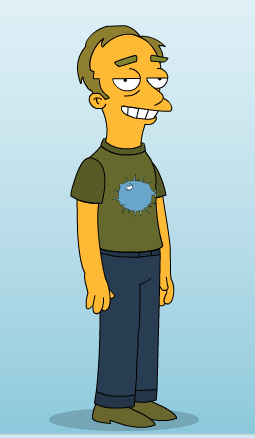
Thanks to a tip from fellow Simpsons fanatic and Cooper colleague Chris Noessel, I discovered that I could generate a Simpsons character with my likeness on the Simpsons Movie site. Holy crap. Truly, a dream come true. Now the only thing left is to have my likeness drawn in the Wall Street Journal "hedcut" style [a PDF on the Dow Jones site about how pictures become WSJ-ready].And it's me, right? Except there were no options for beards, which is strange considering that there are quite a few bearded Simpsons characters. Homer's got a perpetual five o'clock shadow; God has a flowing white beard; Hyman Krustofski has the impressive ZZ Top-style beard befitting a cartoon rabbi; Dr. Marvin Monroe has a beard that is more like mine. So there's got to be lots of existing styles to choose from.When I did a Google search for "simpsons beard," I discovered that Simpsons creator Matt Groening is a self-described beardo, as revealed in this email chat from 1993: "I've been mistaken more than once for Stephen King, Leonard Maltin has been mistaken for me, but I think I look more like a bearded hippie verson of Homer Simpson." (This chat took place on Prodigy, of course. Wow. Simpler times.)
I'm usually the person who recommends going anywhere but Yosemite in the Sierras because it's expensive and tends to be over-run with people even in the high country, whereas the Emigrant Wilderness, for instance, tends to be pretty sparsely visited, even on the busiest of weekends. But let's keep that on the shhhh. Anyway, I spent 3 warm, sunny days in Yosemite last week with my good friend and all-around good guy Andrew Goodman.We had nice weather, went to popular places (North Dome, Yosemite Falls — which has its own Wikipedia page), and yet saw very few other people. Maybe it's the time of year, or the fact that it was a low-snow year, or both? Or our route? We hiked down to North Dome on the Porcupine Creek Trail, and then got back to 120 via the Yosemite Creek trail (where, incidentally, we took some excellent swims). Whatever contributed to it, I've now seen the good side of Yosemite.
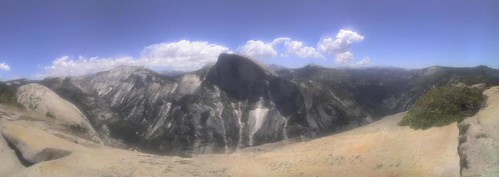 Yosemite Valley from North Dome, rendered via the magic of Autostitch. It assembled 25 or so photos from my Motorola SLVR into a pretty complete panorama, and even the artifacts — moving clouds and ghosted edges — seem to make the result more compelling, I think.
Yosemite Valley from North Dome, rendered via the magic of Autostitch. It assembled 25 or so photos from my Motorola SLVR into a pretty complete panorama, and even the artifacts — moving clouds and ghosted edges — seem to make the result more compelling, I think.Yosemite Valley is an incredible place, especially when seen from a place above the Valley, like North Dome or the outcropping above Yosemite Falls. If you want a glimpse at the Valley was like when people were putting up the first routes on El Cap, check out Glen Denny's photo book, Yosemite in the Sixties. It's really nicely produced and filled with amazing black-and-white images of simpler times and the legends who started it all — Yvon Chouinard, Warren Harding, Royal Robbins, Galen Rowell, and many more.
Years ago, I tried to make a wallet out of a Fedex Tyvek envelope, based on instructions from the inaugural issue of Readymade magazine. I liked the idea of a super-slim wallet that was (a) really cheap without seeming (b) totally cheapskate. The problem was, as simple as it seemed, making the thing involved a sewing machine, a device that is actually somewhat hard (not to mention scary) to use. So I gave up on the idea of having one until about a year and a half ago when I saw one for sale on Etsy for $5.
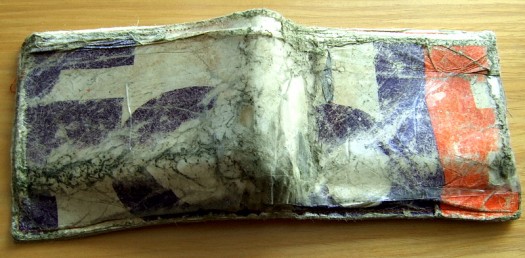 This is my Tyvek wallet after 18 months of use. When I bought it, I figured that it would last for a couple of months before it fell apart, but I was pretty amazed at how well it held up without much outside assistance other than a couple of layers of packing tape now and again.
This is my Tyvek wallet after 18 months of use. When I bought it, I figured that it would last for a couple of months before it fell apart, but I was pretty amazed at how well it held up without much outside assistance other than a couple of layers of packing tape now and again.As long as we're talking about Fedex, here's the cool 70's Fedex logo, and one of those 80's ads with the fast-talking businessman [YouTube]. Next up: a relatively inexpensive wallet from All-Ett that uses silicone-coated ripstop nylon. Doesn't have the cool DIY look of the Fedex wallet, but seems a lot more durable.UPDATE: Just got email from Terrence Kelleman at Dynomighty Design, who designed a wallet made from a thicker, more durable grade of Tyvek and which is held together by gluing and folding rather than stitching. No sewing machines: bonus. Check out his demonstration [You Tube].
This weekend I got an incredible book about San Francisco called San Francisco in Maps & Views. I usually avoid glossy coffee-table historical books because they're so often filled with disappointments — bad color, bad printing, messy layout, uninspired writing, PLUS they're really expensive. But THIS ONE. This one is different. The maps are very well-reproduced, high-res and colorful, and all are supported by detailed and surprisingly engaging commentary. After I got over the initial thrill of using it like a flip-book and watching my neighborhood evolve, I started to notice smaller trends in land-use evolution — a plot labeled "orphan asylum" became "hospital;" many things labeled "cemetary" became "park" or "civic center." "Dunes" become "the Sunset." I was also intrigued by the use of public places as refugee camps after the big one hit in 1906. Apparently, SF carpenters sprang into action and built thousands of makeshift cottages for the earthquake/fire refugees, turning many well-known SF public spaces into refugee camps, including South Park, Dolores Park, and Precita Park, and lots of the then-outlying, undeveloped areas, like the Richmond and the Sunset.
 A shack on Bikini Ridge would have been puh-retty sweet. (This is Dolores Park, believe it or not). Photo: Western Neighborhoods Project
A shack on Bikini Ridge would have been puh-retty sweet. (This is Dolores Park, believe it or not). Photo: Western Neighborhoods ProjectAs the city began to return to normal a year later, a few of the refugees decided to use the cottages — or, "shacks" as they were commonly known — as more permanent residences. Some industrious people combined multiple shacks into one residence. Incredibly, a few shacks are still around, and naturally folks have organized to preserve them. (Here's a 2002 Chronicle article about efforts to save some shacks in the outer Sunset).
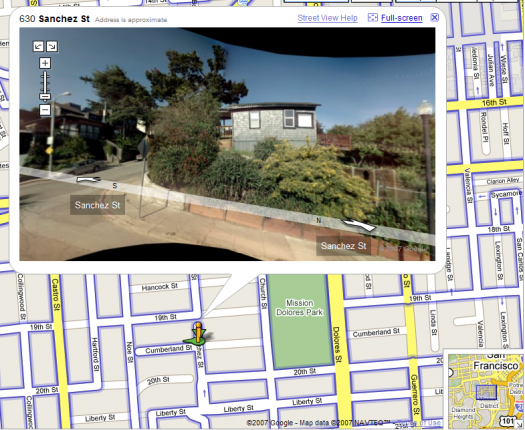 I believe that this is the house that is listed as 300 Cumberland on the Western Neighborhood Project's list of known shacks. The crazy thing is that this is at the top of an insanely steep hill, like un-bike-ably steep and long, so it must have been built there rather than transported from Dolores Park. On the other hand, who knows? People were crafty back then, right?
I believe that this is the house that is listed as 300 Cumberland on the Western Neighborhood Project's list of known shacks. The crazy thing is that this is at the top of an insanely steep hill, like un-bike-ably steep and long, so it must have been built there rather than transported from Dolores Park. On the other hand, who knows? People were crafty back then, right?Finally, here's a map of the locations of the known existing earthquake shacks. Seems like a good project for a weekend afternoon.
Mara and I just moved into the Lower Haight earlier this month, and Google just released a new Maps feature — Street View — that has a picture of our place. If I weren't writing about this, I'd be speechless. Wow.
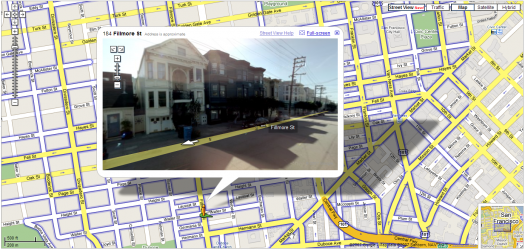 Our place is the yellow two-story walk-up that is bustin out of the top of the frame. I love that it was captured on one of those semi-sunny days where little wisps of fog drift through. So nice to not live in the fog belt. Incidentally, here's the Chronicle's fog forecast. Doesn't look good.
Our place is the yellow two-story walk-up that is bustin out of the top of the frame. I love that it was captured on one of those semi-sunny days where little wisps of fog drift through. So nice to not live in the fog belt. Incidentally, here's the Chronicle's fog forecast. Doesn't look good.Street Level seems like useful functionality, esp. for fancy mobile devices, which I don't have. The controls are pretty straightforward and easy to use on a desktop, but I wonder about the ease with which one could navigate up and down the streets with those teeny arrows on a Palm or Blackberry. This is really nitpicky, but I think it would be effective to introduce more map navigation into the image, i.e. skipping to the next intersection, returning to the original destination, etc. Future-wise, it would be awesome to be able to do stuff with the images — easily insert them into other things, string them together in connection with directions, etc. What I want to know is: How the heck did they do it? Thx, kottke.
Must-see movies / Killer of Sheep
Killer of Sheep is director Charles Burnett's account of life in the LA neighborhood of Watts in the early 1970's. It began life as his senior thesis at UCLA film school and until recently it was never seen outside art houses and museums. Despite all of that, it was among the first 50 films to declared national treasures by the Library of Congress. I saw it earlier this week at the Castro, and it lived up the hype. Burnett's account of his motivations in making the film seems like a good place to start unpacking the stuff that makes it so unique:
I wanted to tell a story about a man who was trying to hold on to some values that were constantly being eroded by other forces, by his plight in the community, and the quality of the job that he had. At the same time he wanted to do right by his family. I didn't want to impose my values on his situation. I just wanted to show his life. And I didn't want to resolve his situation by imposing artificial solutions like him becoming a doctor or a diplomat, when the reality is that most people don't get out. I wanted to show that there is a positive element to his life, and that is that he endures, he's accepted it. [From an excellent interview on Senses of Cinema]
To bring this story to life, he employs a style that seems improvisational, as much documentary as Italian neorealism. But there's also something very new and genuine and particularly American about it — isolation, crumbling buildings, explosions of cruelty and anger, and the constant, chaotic motion of kids leaping across rooftops and crawling under buildings — combined, these things seem to evoke a very American way of poor, urban life.More than anything, the movie makes you wonder at its very improbability: How in the world did he make that? Did he actually plan those moments that seem genuinely serendipitous? Maybe it's that the actors are untrained. The dialogue seems fresh, surprising and authentic even when it's forced. Maybe it's the pacing of the editing. Scenes start abruptly — children emerge from a hole, an entire neighborhood has assembled in a stairwell, kids hide behind a scrap of plywood. Most scenes also tend to end a couple of seconds early, or linger a few seconds longer. Maybe it's the dialogue — it's all mumbles or hollers or growls, with jazz and blues tracks adding rhythmic, sometimes hopeful counterpoints to the imagery. Who knows? What's clear is that it speaks in a true, clear and unique voice. Go see it.

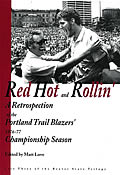
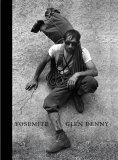

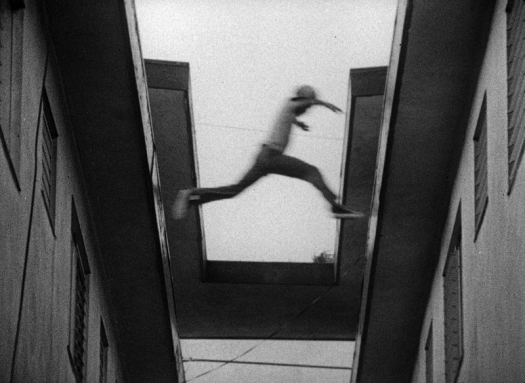 A moment from a beautiful, riveting scene in
A moment from a beautiful, riveting scene in 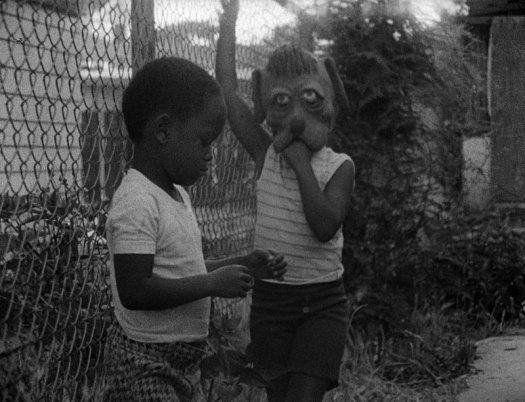 No dialogue. Dog mask. Chain link fence.
No dialogue. Dog mask. Chain link fence.